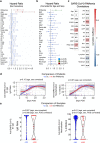SARS-CoV-2 RNAemia and proteomic trajectories inform prognostication in COVID-19 patients admitted to intensive care
- PMID: 34099652
- PMCID: PMC8184784
- DOI: 10.1038/s41467-021-23494-1
SARS-CoV-2 RNAemia and proteomic trajectories inform prognostication in COVID-19 patients admitted to intensive care
Abstract
Prognostic characteristics inform risk stratification in intensive care unit (ICU) patients with coronavirus disease 2019 (COVID-19). We obtained blood samples (n = 474) from hospitalized COVID-19 patients (n = 123), non-COVID-19 ICU sepsis patients (n = 25) and healthy controls (n = 30). Severe acute respiratory syndrome coronavirus 2 (SARS-CoV-2) RNA was detected in plasma or serum (RNAemia) of COVID-19 ICU patients when neutralizing antibody response was low. RNAemia is associated with higher 28-day ICU mortality (hazard ratio [HR], 1.84 [95% CI, 1.22-2.77] adjusted for age and sex). RNAemia is comparable in performance to the best protein predictors. Mannose binding lectin 2 and pentraxin-3 (PTX3), two activators of the complement pathway of the innate immune system, are positively associated with mortality. Machine learning identified 'Age, RNAemia' and 'Age, PTX3' as the best binary signatures associated with 28-day ICU mortality. In longitudinal comparisons, COVID-19 ICU patients have a distinct proteomic trajectory associated with mortality, with recovery of many liver-derived proteins indicating survival. Finally, proteins of the complement system and galectin-3-binding protein (LGALS3BP) are identified as interaction partners of SARS-CoV-2 spike glycoprotein. LGALS3BP overexpression inhibits spike-pseudoparticle uptake and spike-induced cell-cell fusion in vitro.
Conflict of interest statement
King’s College London has filed and licensed a patent application with regard to using PTX3 as a biomarker in sepsis. King’s College London has filed a patent application on the methods used to detect SARS-CoV-2 Spike protein-induced syncytia as described in this paper. A.C.H. is a board member and equity holder in ImmunoQure, A.G., and Gamma Delta Therapeutics, and is an equity holder in Adaptate Biotherapeutics.
Figures








Similar articles
-
Biodistribution and serologic response in SARS-CoV-2 induced ARDS: A cohort study.PLoS One. 2020 Nov 24;15(11):e0242917. doi: 10.1371/journal.pone.0242917. eCollection 2020. PLoS One. 2020. PMID: 33232382 Free PMC article.
-
Recognition and inhibition of SARS-CoV-2 by humoral innate immunity pattern recognition molecules.Nat Immunol. 2022 Feb;23(2):275-286. doi: 10.1038/s41590-021-01114-w. Epub 2022 Jan 31. Nat Immunol. 2022. PMID: 35102342
-
Viral RNA load in plasma is associated with critical illness and a dysregulated host response in COVID-19.Crit Care. 2020 Dec 14;24(1):691. doi: 10.1186/s13054-020-03398-0. Crit Care. 2020. PMID: 33317616 Free PMC article.
-
Quantitative assessment of SARS-CoV-2 RNAemia and outcome in patients with coronavirus disease 2019.J Med Virol. 2021 May;93(5):3165-3175. doi: 10.1002/jmv.26876. Epub 2021 Mar 1. J Med Virol. 2021. PMID: 33590923 Free PMC article.
-
Structural Evaluation of the Spike Glycoprotein Variants on SARS-CoV-2 Transmission and Immune Evasion.Int J Mol Sci. 2021 Jul 10;22(14):7425. doi: 10.3390/ijms22147425. Int J Mol Sci. 2021. PMID: 34299045 Free PMC article. Review.
Cited by
-
Alterations in plasma proteome during acute COVID-19 and recovery.Mol Med. 2024 Aug 25;30(1):131. doi: 10.1186/s10020-024-00898-5. Mol Med. 2024. PMID: 39183264 Free PMC article.
-
Care of the Seriously Ill Patient with SARS-CoV-2.Med Clin North Am. 2022 Nov;106(6):949-960. doi: 10.1016/j.mcna.2022.08.002. Epub 2022 Aug 10. Med Clin North Am. 2022. PMID: 36280338 Free PMC article. Review.
-
Development of a proteomic signature associated with severe disease for patients with COVID-19 using data from 5 multicenter, randomized, controlled, and prospective studies.Sci Rep. 2023 Nov 20;13(1):20315. doi: 10.1038/s41598-023-46343-1. Sci Rep. 2023. PMID: 37985892 Free PMC article.
-
SARS-CoV-2 T Cell Response in Severe and Fatal COVID-19 in Primary Antibody Deficiency Patients Without Specific Humoral Immunity.Front Immunol. 2022 Mar 10;13:840126. doi: 10.3389/fimmu.2022.840126. eCollection 2022. Front Immunol. 2022. PMID: 35359967 Free PMC article.
-
Functional Activity of the Complement System in Hospitalized COVID-19 Patients: A Prospective Cohort Study.Front Immunol. 2021 Oct 28;12:765330. doi: 10.3389/fimmu.2021.765330. eCollection 2021. Front Immunol. 2021. PMID: 34777382 Free PMC article.
References
-
- Vincent JL, et al. The S. O. F. A. (Sepsis-related Organ Failure Assessment) score to describe organ dysfunction/failure. On behalf of the Working Group on Sepsis-Related Problems of the European Society of Intensive Care Medicine. Intensive Care Med. 1996;22:707–710. doi: 10.1007/BF01709751. - DOI - PubMed
-
- Intensive Care National Audit And Research Centre. ICNARC Report on COVID-19 in Critical Care 31 July 2020. (2020).
Publication types
MeSH terms
Substances
Grants and funding
- CS-2016-16-011/DH_/Department of Health/United Kingdom
- MR/V040162/1/MRC_/Medical Research Council/United Kingdom
- RM/17/3/33381/BHF_/British Heart Foundation/United Kingdom
- RG/16/14/32397/BHF_/British Heart Foundation/United Kingdom
- CH/16/3/32406/BHF_/British Heart Foundation/United Kingdom
- FS/18/60/34181/BHF_/British Heart Foundation/United Kingdom
- FC001093/WT_/Wellcome Trust/United Kingdom
- RE/18/2/34213/BHF_/British Heart Foundation/United Kingdom
- MC/PC/15068/MRC_/Medical Research Council/United Kingdom
- FC001093 /WT_/Wellcome Trust/United Kingdom
- MR/R017751/1/MRC_/Medical Research Council/United Kingdom
- FS/19/58/34895/BHF_/British Heart Foundation/United Kingdom
- RG/19/11/34633/BHF_/British Heart Foundation/United Kingdom
- PG/17/48/32956/BHF_/British Heart Foundation/United Kingdom
- FS/17/65/33481/BHF_/British Heart Foundation/United Kingdom
- 106292/Z/14/Z/WT_/Wellcome Trust/United Kingdom
- MC_PC_15068/MRC_/Medical Research Council/United Kingdom
- SP/17/10/33219/BHF_/British Heart Foundation/United Kingdom
- FC001093 /MRC_/Medical Research Council/United Kingdom
- CRUK_/Cancer Research UK/United Kingdom
- FC001093 /CRUK_/Cancer Research UK/United Kingdom
- CH/1999001/11735/BHF_/British Heart Foundation/United Kingdom
LinkOut - more resources
Full Text Sources
Medical
Molecular Biology Databases
Research Materials
Miscellaneous

